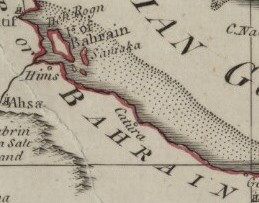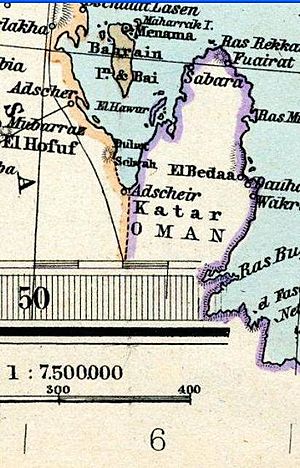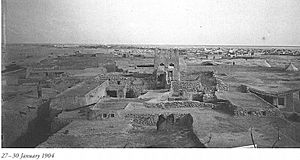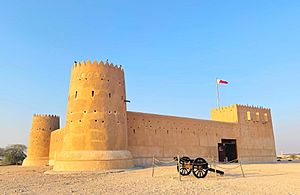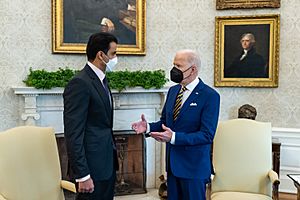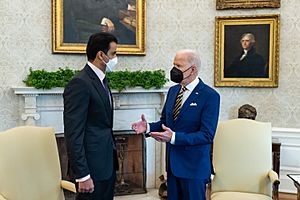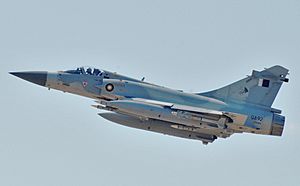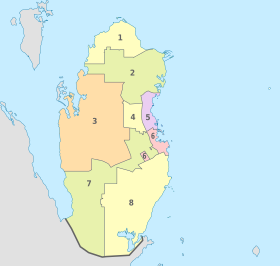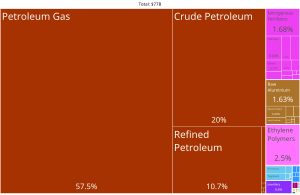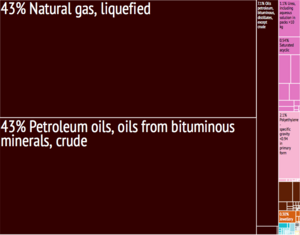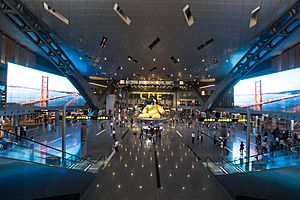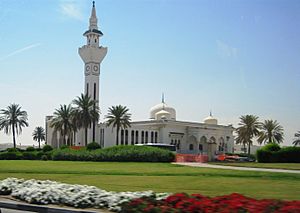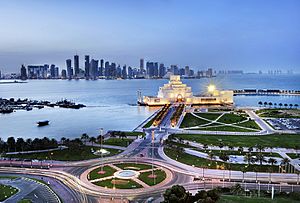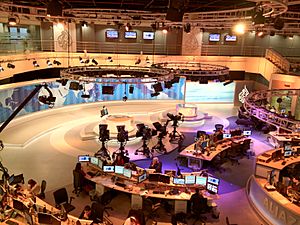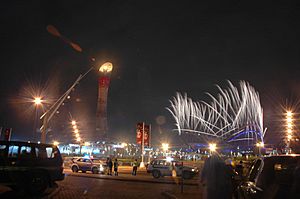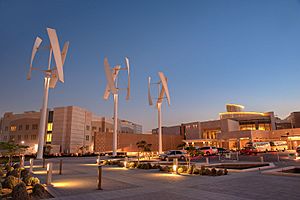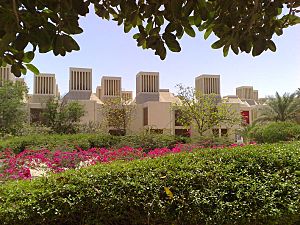Qatar facts for kids
Quick facts for kids
State of Qatar
دولة قطر
Dawlat Qaṭar |
|
|---|---|
|
|
|
|
Anthem: السلام الأميري
As-Salām al-ʾAmīrī "Peace to the Emir" |
|
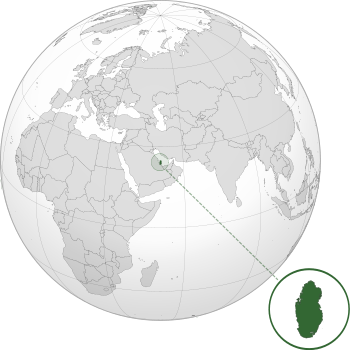
Location and extent of Qatar (dark green) on the Arabian Peninsula
|
|
| Capital and largest city
|
Doha 25°18′N 51°31′E / 25.300°N 51.517°E |
| Official languages | Arabic |
| Ethnic groups
(2019)
|
|
| Religion
(2020)
|
|
| Demonym(s) | Qatari |
| Government | Unitary parliamentary semi-constitutional monarchy under an authoritarian state |
|
• Emir
|
Tamim bin Hamad |
|
• Deputy Emir
|
Abdullah bin Hamad |
| Mohammed bin Abdulrahman | |
| Legislature | Consultative Assembly |
| Establishment | |
|
• Qatar National Day
|
18 December 1878 |
|
• Declared independence
|
1 September 1971 |
|
• Independence from the United Kingdom
|
3 September 1971 |
| Area | |
|
• Total
|
11,581 km2 (4,471 sq mi) (158th) |
|
• Water (%)
|
negligible |
| Population | |
|
• 2023 estimate
|
3,063,005 (139th) |
|
• 2010 census
|
1,699,435 |
|
• Density
|
264/km2 (683.8/sq mi) (76th) |
| GDP (PPP) | 2024 estimate |
|
• Total
|
|
|
• Per capita
|
|
| GDP (nominal) | 2024 estimate |
|
• Total
|
|
|
• Per capita
|
|
| Gini (2007) | 41.1 medium |
| HDI (2022) | very high · 40th |
| Currency | Qatari riyal (QAR) |
| Time zone | UTC+3:00 (AST) |
| Driving side | right |
| Calling code | +974 |
| ISO 3166 code | QA |
| Internet TLD | |
Qatar (pronounced like "KAH-tar" or "kuh-TAR") is a country in Western Asia. It's a small peninsula, a piece of land surrounded by water on three sides. Qatar is located on the northeastern coast of the Arabian Peninsula. It shares its only land border with Saudi Arabia to the south. The rest of its land is surrounded by the Persian Gulf. The capital city is Doha, where most of the country's people live. Qatar's land is mostly flat, low-lying desert.
Qatar has been ruled by the House of Thani family since 1868. It was a British protectorate from 1916 and became fully independent in 1971. The current leader is Emir Tamim bin Hamad Al Thani. He has a lot of power in the government.
Qatar is known for being a very rich country. It has the fourth-highest income per person in the world. This wealth comes from its huge reserves of natural gas and oil. Qatar is one of the biggest exporters of liquefied natural gas (LNG) in the world. In recent years, Qatar has become an important country in the Middle East. It is a close partner of the United States. Qatar is also part of the Gulf Cooperation Council, a group of countries in the region.
Contents
- Understanding the Name: Qatar
- A Look Back in Time: Qatar's History
- How Qatar is Governed: Politics
- How Qatar is Divided: Administrative Divisions
- Qatar's Landscape and Weather: Geography and Climate
- Qatar's Money and Jobs: Economy
- Who Lives in Qatar: Demographics
- Life in Qatar: Culture
- Learning and Knowledge: Education
- Images for kids
- See also
Understanding the Name: Qatar
The name "Qatar" has a long history. A Roman writer named Pliny the Elder mentioned people called Catharrei living on the peninsula around the first century AD. Later, a map from the second century AD called the area Catara.
Over time, the spelling changed through different versions like "Katara," "Katr," and "Kattar." Eventually, the modern name Qatar was adopted. In Arabic, the name is pronounced slightly differently depending on the local dialect.
A Look Back in Time: Qatar's History
Ancient Times in Qatar
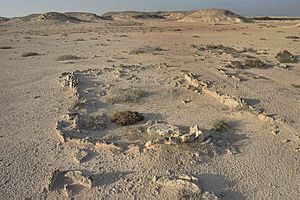
People have lived in Qatar for a very long time, going back 50,000 years! Tools and settlements from the Stone Age have been found here. Ancient objects from Mesopotamia (a very old civilization) have also been discovered. These findings show that people lived and traded in Qatar thousands of years ago.
For example, on Al Khor Island, archaeologists found evidence of trade with the Kassites from ancient Babylonia. They even found millions of crushed snail shells, suggesting that Qatar was an early place for making purple dye from shellfish.
Around 224 AD, the Sasanian Empire took control of the Persian Gulf area. Qatar was important for trade, especially for pearls and purple dye. During this time, many people in Eastern Arabia, including Qatar, learned about Christianity. Later, in 628 AD, the Islamic prophet Muhammad sent a message to the ruler of Eastern Arabia, asking him and his people to accept Islam. Most tribes in the region then became Muslim.
Early Islamic Period and Trade (661–1783)
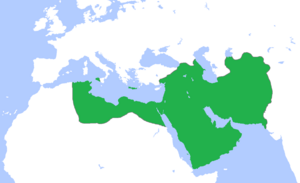
During the Umayyad Caliphate period, Qatar was known for breeding horses and camels. In the 8th century, it became a busy center for pearl trading because of its good location in the Persian Gulf.
The pearling industry grew a lot during the Abbasid Caliphate. Ships traveling from Basra to India and China would stop at Qatar's ports. This led to discoveries of Chinese porcelain and African coins in Qatar. Old ruins from the 9th century show that people built better homes and public buildings, like over 100 stone houses and two mosques, in a place called Murwab.
Later, in the 13th century, a scholar named Yaqut al-Hamawi wrote about Qataris being skilled in making fine woven cloaks and spears.
Changes in Rule (1783–1868)
In 1766, the House of Khalifa family moved to Zubarah in Qatar. In 1783, clans from Qatar and their allies took over Bahrain from the Persians. The Al Khalifa family then ruled both Bahrain and Zubarah.
Later, the Wahhabis from Saudi Arabia tried to expand their territory. They fought with the Al Khalifa and Omanis. Eventually, the Al Khalifa regained power.
In 1821, a British ship attacked Doha because of piracy, causing many people to leave. In 1825, the House of Thani family was formed, with Sheikh Mohammed bin Thani as its first leader.
Qatar was seen as part of Bahrain, but local tribes often disagreed with the Al Khalifa rulers. This led to a war in 1867–1868, where Bahraini forces attacked Doha. The British stepped in to settle the conflict. This settlement in 1868 was important because it recognized Qatar as separate from Bahrain and acknowledged Mohammed bin Thani as its leader. This was a big step towards Qatar becoming its own country.
Ottoman Influence (1871–1915)
In 1871, the House of Thani agreed to Ottoman rule due to pressure from the Ottoman Empire. The Ottomans tried to introduce new rules for taxes and land. However, relations between Qatar and the Ottomans became difficult.
In 1893, a battle known as the Battle of Al Wajbah took place. Ottoman troops tried to force Sheikh Jassim bin Mohammed Al Thani to pay taxes and pledge loyalty. But Jassim and his tribe fought back strongly. The Ottomans were defeated and had to release Qatari leaders they had captured. This battle showed Qatar's strength and helped it become more independent within the Ottoman Empire.
British Protectorate (1916–1971)
In 1913, the Ottomans agreed to leave Qatar, but World War I delayed this. In 1915, with British ships nearby, Sheikh Abdullah bin Jassim Al Thani convinced the remaining Ottoman soldiers to leave.
Qatar officially became a British protectorate on November 3, 1916. This meant Britain would protect Qatar from attacks by sea and help with land attacks. In return, Qatar agreed not to make deals with other countries without Britain's permission.
Oil was first found in Qatar in 1939. However, its development was delayed by World War II. After the war, oil exports began in 1949, and oil money became Qatar's main source of income. This money helped build and modernize the country. In 1968, Britain announced it would leave the Persian Gulf. Qatar then decided to become an independent state, which happened in 1971.
Independence and Modern Qatar (1971–Present)
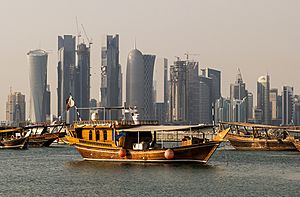
Qatar gained full independence on September 3, 1971. This ended its special agreements with the United Kingdom.
In 1991, Qatar played a role in the Gulf War. It allowed Canadian, US, and French air forces to use its territory. In 1995, Emir Hamad bin Khalifa Al Thani took over leadership from his father. Under his rule, Qatar began to modernize. He launched the Al Jazeera Media Network in 1996, a famous news channel. Women also gained the right to vote in municipal elections in 1999.
In the 21st century, Qatar's economy and influence grew rapidly. Its wealth from natural gas helped it become one of the fastest-growing economies in the world. The population also grew a lot due to many foreign workers coming to the country.
In 2003, Qatar was a main base for the United States Central Command during the 2003 invasion of Iraq. A big moment for Qatar was winning the right to host the 2022 FIFA World Cup in 2010. This was the first time a Middle Eastern country hosted the tournament. This led to even more development and investment in the country.
In 2013, Sheikh Tamim bin Hamad Al Thani became the new Emir. He has focused on improving healthcare and education for Qatar's citizens. He also continued to prepare the country for the World Cup.
In 2017, some neighboring countries cut off diplomatic ties with Qatar. They accused Qatar of supporting certain groups. This led Qatar to build stronger ties with countries like Turkey and Iran. The diplomatic issue ended in 2021. Qatar has also become a mediator in international conflicts, helping with prisoner swaps between the US and Iran.
How Qatar is Governed: Politics
Qatar is officially a semi-constitutional monarchy. This means it has a constitution, but the ruling House of Thani family, led by the Emir, still holds a lot of power. The Al Thani family has been ruling Qatar since 1825.
In 2003, Qatar approved a constitution. This constitution allowed for some members of the legislature (the law-making body) to be directly elected by the people.
The Emir has the power to appoint the prime minister and other ministers. These ministers form the Council of Ministers, which is the main executive body. The Consultative Assembly has 45 members; 30 are elected by the people, and 15 are chosen by the Emir. This assembly can block new laws and can even remove ministers.
Laws in Qatar
Qatar's laws are a mix of civil law and Sharia law. Sharia law is the main source of legislation according to the constitution. It is used for family matters, inheritance, and some criminal cases.
In 2014, a campaign was launched to remind tourists about the country's dress code. Female tourists were advised to dress modestly in public, avoiding very short or tight clothing. Men were also advised against wearing only shorts and singlets.
Qatar's Role in the World: Foreign Relations
Qatar has become an active player in international affairs. It is seen as a "middle power" because of its growing influence. Since 2022, it has been a major non-NATO ally of the United States. Qatar also has strong ties with countries like France, China, Iran, and Turkey.
Qatar is a founding member of the Gulf Cooperation Council (GCC) and the Arab League. It tries to keep good relationships with many different countries and groups. This "open-door" foreign policy helps Qatar secure its interests as a smaller state in the region.
Qatar has also become known for its role as a mediator in conflicts. For example, it helped bring together rival groups in Palestine and Lebanon. It has also hosted peace talks for Sudan and Afghanistan. Qatar played a big role in setting up the first ceasefire and hostage exchange during the 2023 Israel-Hamas war.
Qatar's Military
The Qatar Armed Forces are the country's military. It is a small but modern force. Qatar has signed defense agreements with the United States and the United Kingdom. It also works with other members of the Gulf Cooperation Council for defense. The large Al Udeid Air Base, used by the United States, helps ensure Qatar's security.
Qatar has been increasing its military spending and buying advanced weapons. It was one of the largest arms importers in the world in recent years.
Human Rights in Qatar
Like many countries, Qatar is working to improve its human rights situation. The country gave women the right to vote in municipal elections in 1999, at the same time as men. These first elections were held on International Women's Day.
There are ongoing efforts to improve conditions for migrant workers, who make up a large part of the workforce. Qatar has also passed laws to prevent cybercrime, which aim to protect people online.
How Qatar is Divided: Administrative Divisions
Since 2014, Qatar has been divided into eight main areas called municipalities (baladiyah in Arabic). These are:
- Al Shamal
- Al Khor
- Al-Shahaniya
- Umm Salal
- Al Daayen
- Doha
- Al Rayyan
- Al Wakrah
These municipalities are further divided into smaller areas called zones and then into blocks for statistics.
Qatar's Landscape and Weather: Geography and Climate
The Qatari peninsula stretches about 100 kilometers (62 miles) into the Persian Gulf. Most of the country is a low, flat plain covered with sand. In the southeast, there's a unique area called the Khor al Adaid (or "Inland Sea"). This area has rolling sand dunes surrounding an inlet of the Persian Gulf.
Qatar has mild winters and very hot, humid summers. The highest point in Qatar is Qurayn Abu al Bawl, which is 103 meters (338 feet) high. It's located in the Jebel Dukhan area in the west. This area also has Qatar's main onshore oil deposits. The large natural gas fields are found offshore, to the northwest.
Animal and Plant Life: Biodiversity
Qatar is working to protect its natural environment. It has created a Biodiversity Action Plan to help preserve its plants and animals. Over 140 types of fungi have been found in Qatar. A recent book also lists the different types of lizards that live in the country.
Weather Patterns: Climate
| Climate data for Qatar | |||||||||||||
|---|---|---|---|---|---|---|---|---|---|---|---|---|---|
| Month | Jan | Feb | Mar | Apr | May | Jun | Jul | Aug | Sep | Oct | Nov | Dec | Year |
| Mean daily maximum °C (°F) | 22 (72) |
23 (73) |
27 (81) |
33 (91) |
39 (102) |
42 (108) |
42 (108) |
42 (108) |
39 (102) |
35 (95) |
30 (86) |
25 (77) |
33 (92) |
| Mean daily minimum °C (°F) | 14 (57) |
15 (59) |
17 (63) |
21 (70) |
27 (81) |
29 (84) |
31 (88) |
31 (88) |
29 (84) |
25 (77) |
21 (70) |
16 (61) |
23 (74) |
| Average precipitation mm (inches) | 12.7 (0.50) |
17.8 (0.70) |
15.2 (0.60) |
7.6 (0.30) |
2.5 (0.10) |
0 (0) |
0 (0) |
0 (0) |
0 (0) |
0 (0) |
2.5 (0.10) |
12.7 (0.50) |
71 (2.8) |
| Sea Climate Data For Doha | |||||||||||||
|---|---|---|---|---|---|---|---|---|---|---|---|---|---|
| Month | Jan | Feb | Mar | Apr | May | Jun | Jul | Aug | Sep | Oct | Nov | Dec | Year |
| Average sea temperature °C (°F) | 21.0 (69.8) |
19.4 (66.9) |
20.9 (69.6) |
23.3 (73.9) |
27.8 (82) |
30.5 (86.9) |
32.4 (90.3) |
33.6 (92.5) |
32.8 (91) |
30.8 (87.4) |
27.5 (81.5) |
23.5 (74.3) |
26.9 (80.5) |
Qatar's Money and Jobs: Economy
Before oil was discovered, Qatar's economy relied on fishing and pearl hunting. But when cultured pearls became popular in the 1920s and 1930s, the pearling industry declined.
Oil was found in Qatar in 1940, and this changed everything. Qatar now has a very high standard of living for its citizens. There is no income tax, making it one of the countries with the lowest tax rates. The unemployment rate is very low, almost zero.
Qatar's economy relies heavily on its oil and natural gas industries. It is the world's leading exporter of liquefied natural gas (LNG). In 2012, Qatar was named the richest country in the world based on income per person.
The Qatar Investment Authority (QIA) was set up in 2005. It's a special fund that invests Qatar's oil and gas money around the world. QIA has invested in many famous companies and properties in the United States, Europe, and Asia.
Recently, Qatar has started to plan for taxes on things like junk food and luxury items. This is partly because of changes in oil prices.
Powering the Nation: Energy
Qatar has huge oil reserves (15 billion barrels) and the world's third-largest natural gas reserves. This makes it a very rich country. Almost no one lives below the poverty line, and unemployment is very low.
While oil production will eventually decrease, Qatar's massive natural gas reserves will continue to power its economy. Qatar is also investing in heavy industries like refineries and chemical plants, mostly located in Umm Said. These industries use natural gas as fuel.
Qatar is also looking into solar power. By 2030, it aims to get 20% of its energy from solar power. The country has a lot of sunshine, making it a good place for solar energy. Organizations like Qatar Foundation are helping to achieve these solar goals.
Getting Around: Transport
As Qatar's population and economy grow, it needs a good transportation system. The government is working hard to build new roads, public transport, and expand its airports and ports.
Driving is the main way people get around, so the road network is a big focus. Projects like the Doha Expressway are being built. New public transport options like the Doha Metro and a light-rail system are also being developed to ease traffic.
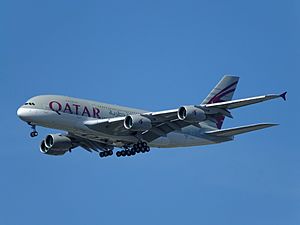
The Hamad International Airport in Doha is Qatar's main airport. It's one of the busiest airports in the world. Qatar is also improving its ports, like Hamad Port, to boost trade between Europe, China, and Africa.
Qatar Airways is one of the largest airlines in the world. It connects Doha to over 160 international destinations.
Who Lives in Qatar: Demographics
| Historical population | ||
|---|---|---|
| Year | Pop. | ±% |
| 1950 | 25,000 | — |
| 1960 | 47,000 | +88.0% |
| 1970 | 110,000 | +134.0% |
| 1980 | 224,000 | +103.6% |
| 1990 | 476,000 | +112.5% |
| 2000 | 592,000 | +24.4% |
| 2010 | 1,856,000 | +213.5% |
| 2019 | 2,832,000 | +52.6% |
| source: | ||
Qatar's population changes a lot depending on the time of year. This is because many people who live and work there are foreigners (people from other countries). In early 2017, Qatar had 2.6 million people. Only about 313,000 (12%) were Qatari citizens. The rest were expatriates.
A large number of these expatriates come from South Asia. For example, there are many people from India, Nepal, Bangladesh, Sri Lanka, and Pakistan. Other large groups include people from the Philippines and Egypt.
Qatar's population has grown very quickly. In 2001, there were just over 600,000 people. By 2011, the population had tripled! This means that Qatari citizens make up a smaller part of the total population.
Beliefs and Faiths: Religion
Islam is the main religion in Qatar and is the official state religion. Most Qatari citizens follow the Salafi movement of Wahhabism. However, the constitution allows people to practice other faiths as long as they follow moral rules.
Many different religions are practiced in Qatar. In 2010, about 67.7% of the population was Muslim, 13.8% Christian, 13.8% Hindu, and 3.1% Buddhist.
Since 2008, Christians have been allowed to build churches on land given by the government. There are several active churches in Qatar, including Catholic and Anglican churches.
Speaking in Qatar: Languages
Arabic is the official language of Qatar. The local dialect is called Qatari Arabic. English is also widely used as a second language, especially in business and for communicating with the large number of foreign residents.
Because many different nationalities live in Qatar, many other languages are spoken too. These include Persian, Hindi, Malayalam, Urdu, and Tagalog, among others.
Qatar joined the international French-speaking organization La Francophonie in 2012.
Staying Healthy: Healthcare
Healthcare in Qatar is generally of a high standard. Qatari citizens have a national health insurance plan. Foreigners usually get health insurance from their employers.
Qatar spends a lot on healthcare, one of the highest amounts in the Middle East. The main healthcare provider is the Hamad Medical Corporation. It runs hospitals, ambulance services, and home healthcare services.
In 2014, the average life expectancy in Qatar was 82.08 years, which is the highest in the Middle East. Qatar also has a very low infant mortality rate.
Life in Qatar: Culture
Qatar's culture is similar to other countries in Eastern Arabia. It is strongly influenced by Islam. Qatar National Day, celebrated every year on December 18, is important for building a sense of national identity. It remembers when Jassim bin Mohammed Al Thani became ruler and united the country's tribes.
Art and Museums
Qatari officials, especially the Al Thani family, pay a lot of attention to art. Sheikha Al-Mayassa bint Hamad bin Khalifa Al Thani, the sister of the Emir, is working to build a creative future for Qatar.
The Museum of Islamic Art, opened in 2008, is considered one of the best museums in the region. There is also the Arab Museum of Modern Art. These museums are part of the Qatar Museums Authority (QMA). Qatar is one of the biggest buyers in the global art market.
Stories and Poems: Literature
Qatari literature began in the 19th century. At first, poetry was the most common form of writing. Poets like Abdul Jalil Al-Tabatabai wrote early Qatari poems.
Later, as Qatar became rich from oil, many people moved to cities and changed their lifestyles. In the 1970s, the first short story collections were published. The first novels written by local authors came out in 1993. Women have been just as involved as men in developing modern Qatari literature.
News and Media
TV broadcasting in Qatar started in 1970. Al Jazeera is a major television network based in Doha. It started in 1996 as an Arabic news channel and has grown into a global network.
There are currently seven newspapers in Qatar. Four are in Arabic, and three are in English. Some newspapers from India, Nepal, and Sri Lanka also print editions in Qatar.
Qatar is highly ranked for its communication technology. This means it has good internet and phone services.
Sounds of Qatar: Music
The music of Qatar is based on Bedouin poetry, songs, and dances. Traditional dances, like the Ardah, are performed with percussion instruments. These instruments include large drums, tambourines, and cymbals. String instruments like the oud are also used.
Games and Sports: Sport
Association football (soccer) is the most popular sport in Qatar. The Qatar national under-20 football team was a runner-up in the FIFA World Youth Championship in 1981. Qatar has hosted the AFC Asian Cup twice. In 2019, the Qatar national football team won the AFC Asian Cup for the first time, beating Japan in the final.
On December 2, 2010, Qatar won the bid to host the 2022 FIFA World Cup. This was a huge event, making Qatar the first Middle Eastern country to host it. New stadiums were built, and the country prepared to welcome millions of fans. The World Cup in Qatar was the most expensive in history and featured many modern technologies.
Besides football, other team sports are also popular. The Qatar men's national handball team was a runner-up in the World Men's Handball Championship in 2015. Qatar also won the world championship in men's 3x3 basketball in 2014.
Cricket is popular among people from South Asia living in Qatar. The Qatar Cricket Association is a member of the International Cricket Council. Basketball is also growing in popularity. Qatar will host the 2027 FIBA Basketball World Cup, making it the first Arab country to do so.
Doha has hosted major tennis tournaments, like the WTA Tour Championships. The annual Tour of Qatar is a cycling race that takes place across the country's flat land. The Qatar Army Skydiving Team is also very skilled and performs at national events.
Learning and Knowledge: Education
Qatar has invested a lot in its education system. Through the Qatar Foundation, it has built Education City. This campus has branches of famous international universities, like Weill Cornell Medical College and Georgetown University.
The illiteracy rate in Qatar is very low, one of the lowest in the Arab world. Citizens are required to attend government schools from kindergarten through high school. Qatar University, founded in 1973, is the country's oldest and largest university.
In 2002, the Supreme Education Council was created to oversee education in Qatar. It aims to make Qatar a leader in education reform.
In 2009, the Qatar Science & Technology Park was opened in Education City. It connects universities with industries to help Qatar move towards a knowledge-based economy.
Qatar has a 10-year plan to improve education even further. Programs like Al-Bairaq help high school students get experience in scientific research.
New Discoveries: Science and Technology
The Qatar National Research Fund was created in 2006 to support scientific research. This is part of Qatar's plan to diversify its economy. It wants to rely less on oil and gas and more on knowledge and innovation.
The Qatar Science & Technology Park (QSTP) was also established to help with this goal. It's Qatar's first free-trade zone and hosts many organizations focused on technology and research.
Images for kids
-
Qatar Armed Forces AMX-10 RC during a multilateral exercise.
See also
 In Spanish: Catar para niños
In Spanish: Catar para niños




